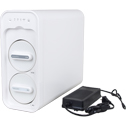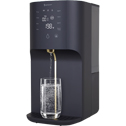Is Fluoride in Water Good or Bad? Understanding Your Options
 Andrew
May 22, 2025
#contaminants
#filterreplacement
#fluoride
#pointofuse
#reverseosmosis
#romembrane
#waterquality
Andrew
May 22, 2025
#contaminants
#filterreplacement
#fluoride
#pointofuse
#reverseosmosis
#romembrane
#waterquality

The discussion around whether fluoride in water is good or bad, however, isn't straightforward. Proponents cite decades of public health data showing reduced dental problems in communities with fluoridated water. Meanwhile, some consumers express concerns about health concerns from potential overconsumption, especially when considering additional fluoride sources such as toothpaste and certain food. Public fluoridation also raises questions for some about personal liberty.
Rather than debating the merits of fluoridation policy, a practical approach for homeowners is understanding specific water composition and available filtration options. Every water supply contains a unique profile of minerals, treatment chemicals, and possible contaminants, and fluoride is just one component of this complex mixture. In fact, some individuals are so sensitive to the chlorine or chloramine specifically used to disinfect their water, they have to use filters to reduce it before drinking or showering.
How do you know if your water contains fluoride? Start by requesting a Consumer Confidence Report (also called a Water Quality Report) from your local water utility. If you use well water, consider comprehensive testing through a certified laboratory to identify both fluoride levels and other potential water quality concerns. Well owners should test annually regardless, to identify changes to their groundwater that may require new filtration.

So how do you remove fluoride from your drinking water and what type of water filter removes fluoride most effectively? Here's what you need to know about common filtration options:
- Carbon filtration: Most basic carbon filters, including pitcher filters and refrigerator filters, do not remove significant amounts of fluoride. While excellent for improving taste, reducing odor, and taking care of chlorine, both activated carbon and catalytic carbon have limited effectiveness against fluoride ions.
- Specialty media filters: Some specialized filter media, particularly aluminum oxide, activated alumina, and bone char carbon, demonstrate good fluoride removal capabilities. These materials can be found in certain countertop filters and under-sink systems specifically designed for fluoride reduction.
- Distillation: Home distillation systems effectively remove fluoride along with nearly all other water impurities. However, they typically process water slowly, consume significant electricity, and remove beneficial minerals along with contaminants.
- Reverse osmosis: Reverse osmosis technology stands as the most efficient residential solution for fluoride removal, typically eliminating 85-95% of fluoride content, along with a long list of other soluble minerals and impurities. These systems use a semi-permeable membrane to filter water at the molecular level, removing not only fluoride but also lead, arsenic, nitrates, and many other concerns. The comprehensive filtration capabilities make reverse osmosis an ideal choice for households concerned about multiple water quality issues beyond just fluoride.

For the question how to remove fluoride from water specifically, point-of-use filtration (treating water at a single tap) is often more practical than whole-house treatment. Since concerns about fluoride primarily relate to consumption rather than bathing or cleaning, targeted filtration at drinking water taps offers the most cost-effective approach. Though whole-home RO might seem appealing, it is typically both unnecessary and cost prohibitive. Other whole-house water filters use a sequence of sediment, carbon, descaler, and other filtration types to improve water quality before it enters your home's pipes, but are not always ideal for tackling fluoride, specifically.
A quality under-sink reverse osmosis system typically costs between $150–300 initially, with replacement filters needed every 6–12 months depending on water quality and usage. Even better, advances in residential RO systems using booster pumps mean higher flow rates to serve more uses in the kitchen, and countertop varieties add a flexible option for RO water almost anywhere. While any system represents an initial investment, many homeowners find the comprehensive contaminant removal and improved water quality worth the expense, and a more sustainable and cost-effective solution than bottled water.
Remember that proper maintenance helps ensure filters are working. When using reverse osmosis systems, watch for changes in water quality and supply and keep an eye on pre-filters to make sure they aren't clogging, which can slow the flow and damage the membrane.
For those specifically seeking a filter to remove fluoride, the combination of quality and comprehensive filtration makes reverse osmosis the standard recommendation. These systems not only address fluoride concerns but also provide protection against a wide spectrum of other potential water quality issues by reducing or removing hundreds of impurities.
To sum up, the ultimate goal isn't just addressing a single substance like fluoride, but gaining control over your home's water quality overall. By understanding what's in your water, researching appropriate filtration technologies, and implementing a targeted solution, you can ensure your household enjoys clean, safe water tailored to your individual preferences and needs.






